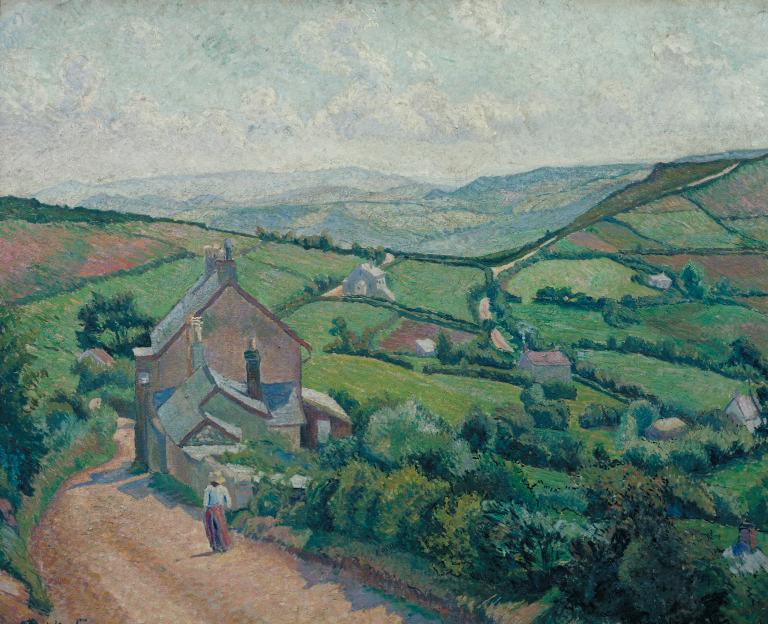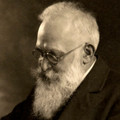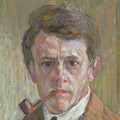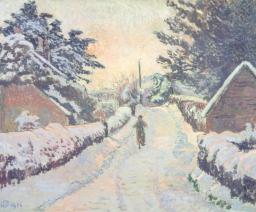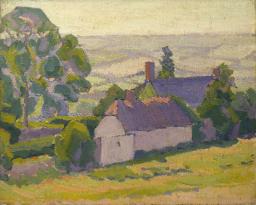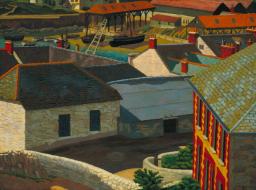Lucien Pissarro High View, Fish Pond 1915
Lucien Pissarro,
High View, Fish Pond
1915
A woman in a sun-hat walks down a brightly lit road towards a house called ‘High View’, which lends its name to the title of this painting. Pissarro lived in the small village of Fishpond, Dorset, during the First World War, where he painted numerous landscapes that create an almost complete panorama of the surrounding views. The pattern of roads and fields in the middle ground is characterised by a solidity of colour and marked definition of planes; the bushes in the foreground are outlined in blue paint.
Lucien Pissarro 1863–1944
High View, Fishpond
1915
Oil paint on canvas
533 x 648 mm
Inscribed ‘LP’ in monogram and ‘1915’ bottom left and ‘High View Fishpond’ in ink on back top member
Presented by the Contemporary Art Society 1917
N03179
1915
Oil paint on canvas
533 x 648 mm
Inscribed ‘LP’ in monogram and ‘1915’ bottom left and ‘High View Fishpond’ in ink on back top member
Presented by the Contemporary Art Society 1917
N03179
Ownership history
Purchased from the artist by the Contemporary Art Society 1915, by whom presented to Tate Gallery 1917.
Exhibition history
1923
Exhibition of Paintings and Drawings held at Grosvenor House, Contemporary Art Society, London, June–July 1923 (135).
1937
Loan Collection of British Masters from National and Tate Galleries, National Gallery of New South Wales, Sydney, Australia, August 1937 (40).
1963
Lucien Pissarro 1863–1944: A Centenary Exhibition of Paintings, Watercolours, Drawings and Graphic Work, (Arts Council tour), Arts Council Gallery, London, January–February 1963, Manchester City Art Gallery, March 1963, Bristol City Art Gallery, April 1963, Dundee City Art Gallery, May 1963, The Minories, Colchester, June 1963, Ashmolean Museum, Oxford, July 1963 (34).
1970–5
Bowes Museum, Barnard Castle, September 1970–May 1975 (long loan).
2000
Camille Pissarro and his Descendants, Museum of Art, Fort Lauderdale, Florida, January–April 2000 (88, reproduced p.122).
2008
Modern Painters: The Camden Town Group, Tate Britain, London, February–May 2008 (91, reproduced).
References
1916
J.B. Manson, ‘Some Notes on the Painting of Lucien Pissarro’, Studio, vol.69, November 1916, reproduced p.63.
1926
J.B. Manson, Hours in the Tate Gallery, London 1926, pp.127–8.
1929
J.B. Manson, The Tate Gallery, London 1929, p.140.
1937
Teachers World and Schoolmistress, 28 July 1937, reproduced p.9.
1962
W.S. Meadmore, Lucien Pissarro: Un Coeur Simple, London 1962, pp.150–2.
1964
Mary Chamot, Dennis Farr and Martin Butlin, Tate Gallery: The Modern British Paintings, Drawings and Sculpture, vol.2, London 1964, p.526.
1983
Anne Thorold, A Catalogue of the Oil Paintings of Lucien Pissarro, London 1983, no.210, reproduced p.115.
Technique and condition
High View, Fishpond is painted on a grey-white ground, with very little ground left visible. The painting is matt with no varnish, and is confidently painted with few paint mixture campaigns. The colours are calm and involve subtle variation. There are expressive brushmarks in the sky, and the foreground is strengthened with a blue-black painted line to demarcate the bushes. Pissarro has depicted atmospheric perspective and used cool shadows to indicate sunshine. It is opaquely painted with no deliberate glazes. He has used a less-loaded brush and a more linear depiction of form. Tractable paint indicates where the artist has rapidly lifted his brush from the canvas. Pin holes in the corners and middle of the edges of this work are probably canvas separators indicating the painting was done out of doors in situ and carried back to the studio.
Stephen Hackney
July 2003
How to cite
Stephen Hackney, 'Technique and Condition', July 2003, in David Fraser Jenkins, ‘High View, Fishpond 1915 by Lucien Pissarro’, catalogue entry, October 2002, in Helena Bonett, Ysanne Holt, Jennifer Mundy (eds.), The Camden Town Group in Context, Tate Research Publication, May 2012, https://wwwEntry
Fishpond in Dorset is a small village near the ridge of a hill looking south towards the sea at Charmouth, three miles away. The ‘High View’ of the title is the name of the house in the foreground.1 This panoramic view, from a turning off the road to Crewkerne, looks out over the hills on a summer day. The overall light tonality reveals the sunlight on the road and the roofs in the foreground, where a woman wearing a large sun-hat walks by. The viewpoint brings out the pattern of roads in the middle ground and the compartmented shapes of fields and farmhouses, with the hills in the distance appearing blue, bearing similarities with Robert Bevan’s and Charles Ginner’s structured portrayals of the landscape (fig.1). In comparison to Pissarro’s earlier painting of Epping in Essex (Tate N04747, fig.2), the colours here are less brilliant, and are not applied in such an ordered way. The sunlight falling from one side creates a strong contrast of light and shade, and the shapes of the bushes in the foreground have been strengthened with outlines drawn over in blue paint.
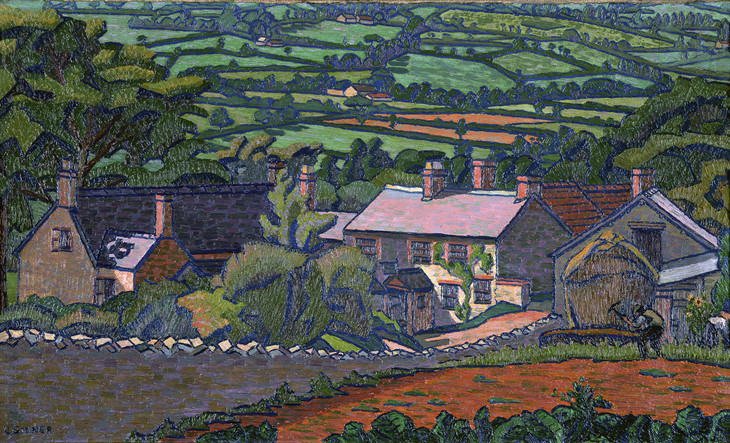
Charles Ginner 1878–1952
Clayhidon 1913
Oil paint on canvas
384 x 639 mm
Royal Albert Memorial Museum, Exeter
© Estate of Charles Ginner
Photo © Royal Albert Memorial Museum, Exeter, Devon, UK / The Bridgeman Art Library
Fig.1
Charles Ginner
Clayhidon 1913
Royal Albert Memorial Museum, Exeter
© Estate of Charles Ginner
Photo © Royal Albert Memorial Museum, Exeter, Devon, UK / The Bridgeman Art Library
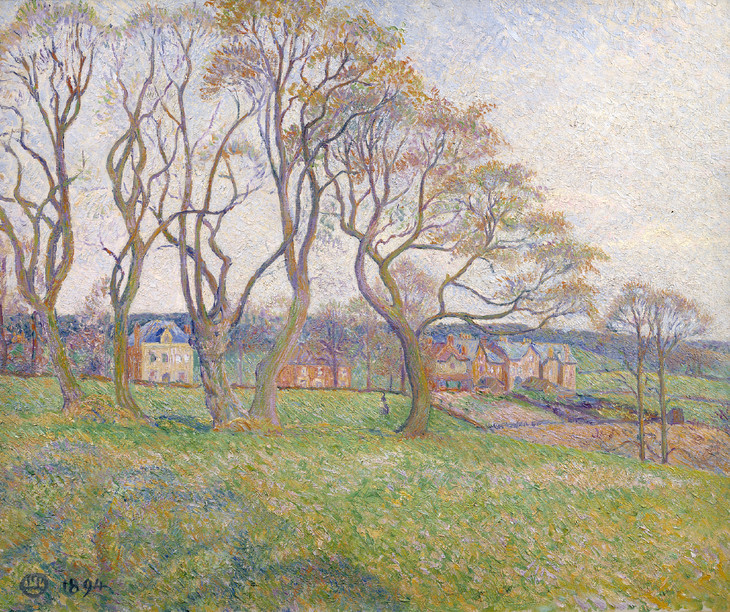
Lucien Pissarro 1863–1944
April, Epping 1894
Oil paint on canvas
support: 603 x 730 mm
Tate N04747
Presented by the Trustees of the Chantrey Bequest 1934
© Tate
Fig.2
Lucien Pissarro
April, Epping 1894
Tate N04747
© Tate
Pissarro did not paint in London during the First World War, fearing that people might think he was a foreign spy and that he might be breaking the law. As he was also short of money, he sub-let his house, The Brook, on Stamford Brook Road in Chiswick for almost the entire period, and rented a series of houses in country villages in the south of Britain. He lived at Seaview Cottage in Fishpond from May to November 1915.2 From there he sent his finished paintings to his friend J.B. Manson, then Chief Clerk at the Tate Gallery, who attempted to sell them to private collectors and to the Tate itself. On 13 August 1915 he wrote to Pissarro: ‘Your pictures arrived safely. They are beautiful, particularly the one of the hills, which is very fine indeed. [Director of the Tate Gallery, Charles] Aitken likes it very much and thinks perhaps the Contemporary Art Society will buy it.’3 Later on, Manson singled out High View, Fishpond as the best: ‘Go to it, my dear old man. You are surpassing yourself. I think the High View is a masterpiece.’4
Fourteen landscapes of the area around Fishpond are listed in Anne Thorold’s catalogue of Pissarro’s oil paintings for this year.5 Taken together, they resemble a complete panorama of distant views around Fishpond. Most of the pictures apart from Tate’s were exhibited within a few years at the New English Art Club or the Goupil Gallery but only a few appear to have sold – one to the Vice-Chancellor of the University of Leeds, Michael Sadler, in 1915, one to the National Art Collections Fund in 1916 which presented it to the Manchester City Art Gallery, and one to Charles Aitken, Director of the Tate Gallery.
Sadler’s letter seeking to acquire a painting was forwarded to Pissarro by Manson. There was some arrangement about an exchange, which Pissarro replied was near to ‘the ideal state when artists will be able to give the work they produce to those who really like it without being obliged by necessity to treat their art as merchandise’.6 Sadler later offered an earlier painting he already owned, Eden Valley 1914,7 as a gift to the Tate Gallery through the Contemporary Art Society, but it was declined by the Trustees at the same meeting in June 1917 at which they accepted High View. Professor Michael Sadler (1861–1943), Vice Chancellor of the new University of Leeds, was then building a substantial collection of British and European modern art.8 He later presented Eden Valley to the Contemporary Art Society, which gave it in 1924 to the Harris Museum and Art Gallery, Preston. Other artists he then supported included Mark Gertler, Paul Nash, John Nash, Stanley Spencer, C.R.W. Nevinson and Jacob Kramer.
Manson’s article in the Studio of November 1916 was the first illustrated study of Pissarro’s paintings, and of the nine illustrations four were of paintings near Fishpond from 1915. Manson’s view was that in Pissarro’s recent paintings the ‘more compact organisation of colour values’ led to ‘the expression of a greater solidity and a more marked definition of planes’, so that the work ‘has become more intellectual’.9 He positioned Pissarro’s style as distinct from, and preferable to, vorticism and Roger Fry’s post-impressionism, both of which he disliked. Manson again praised this painting in his books about the Tate Gallery of 1926 and 1929, arguing that, although the subject was so ordinary that it had no popular appeal, it was ‘uncompromising in its realism ... but the truth of its relations and the subtlety of its colour values is wonderful’.10
Pissarro returned to Fishpond much later, in 1940, to escape the bombing of London, and painted three pictures there.
David Fraser Jenkins
October 2002
Notes
Related biographies
Related catalogue entries
How to cite
David Fraser Jenkins, ‘High View, Fishpond 1915 by Lucien Pissarro’, catalogue entry, October 2002, in Helena Bonett, Ysanne Holt, Jennifer Mundy (eds.), The Camden Town Group in Context, Tate Research Publication, May 2012, https://www

